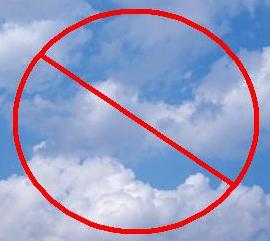As 2011 is now done and dusted I went back through the Excel spreadsheet I have been compiling of clear nights and cloudy ones in my area of the UK (central South Coast of England) and, because I now have two years’ worth of data I could compare 2010 and 2011. I have separated the partly clear nights from the completely clear ones but ‘partly cloudy’ does not mean sucker holes, it means that the sky is at least 50% clear and observing is still possible. Sucker holes mean the scope stays tucked up in the shed and I remain watching tv or surfing the net, unless there is a comet or another event.
The winter of 2010/2011 was exceptionally cloudy and, according to reports, the UK received only 40% of the sunlight it should have during that winter. October 2010 had 10 completely clear nights and 2 partly cloudy ones, November only 2 clear nights and 2 partly clear ones and December 4 clear nights and 1 partly cloudy one. January 2011 had 3 clear nights and 1 partly clear, February was exactly the same and it wasn’t until March that the skies cleared substantially.
The current winter, 2011/12 is slightly better so far; except October 2011 which was worse than October 2010, with 7 clear nights and 1 partly clear one, while November had 1 clear night and 7 partly clear ones and December had 6 clear nights and 2 partly clear ones.
2010 in total had 116 completely clear nights (32% of nights) and 54 partly clear (15%) ones – a total of 170 usable nights (47%)
2011 had 104 clear nights (28%) and 52 partly clear (14%) ones – a total 156 observationally usable nights (43%).
2011 was, as suspected, a cloudier year than 2010 was. However, I’ll carry on doing this over the years and see whether the years get worse, improve or – as most likely – they vary.
We do get more clear nights than we think but I wish it were possible to use all of them…!
—————————————————————————————————————————————————————————————-
2012 means I’ve been involved in astronomy for 20 years. I got into the hobby seriously in 1992, when I left the Royal Navy, and began deep sky observing in 1993 and, if you’re interested, I wrote about it here. I was 22 and knew nothing. I still don’t…!
It’s been all positive and the best thing I ever done was get into this hobby – actually, no, more ‘way of life’ than hobby. Apart from the wonders of the universe, the fabulous people I have met make me regret absolutely nothing about joining the ranks of amateur astronomers. Ok, I do have one regret and that’s why did I not get into this sooner?! Yes, I live in a country with a questionable climate but I still get enough observing in to keep me (reasonably) happy, augmented with trips to sunnier climes and star parties. I am going to celebrate 20 years of the best of hobbies with a trip to the 2012 Texas Star Party (my 4th TSP – please, no volcanoes or other hassles to disrupt flights!) and I have my 18 inch Dob which I am hoping to make serious inroads into the Herschel 2500 and galaxy groups and clusters with over the coming years.
So far (copied and pasted from Astronomy and Me pt 2 on here) – “…on going back through the old notebooks and sketchbooks (unfortunately I have two or three missing) I find I have visually observed best part of a thousand NGC/IC objects and non-NGC/IC objects such as anonymous galaxies and galaxy clusters. On top of that, there’s all the planets (including ex-planet Pluto), double and multiple stars, the Moon(!), asteroids, a comet crashing into Jupiter, comets, lunar eclipses, partial solar eclipses with one cloud obstructed total in 1999, a transit of Venus, the Sun, occultations, meteor showers, noctilucent clouds, Mir, the ISS, the Space Shuttle and other satellites…but, sadly, no UFOs! All these with equipment ranging from my unaided eyes to a 48 inch dobsonian.”
Here’s to the next 20 years and more…Happy New Year everyone!















